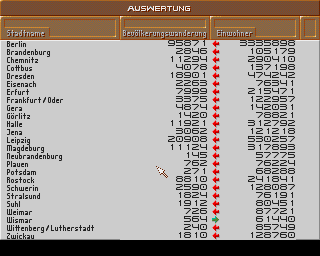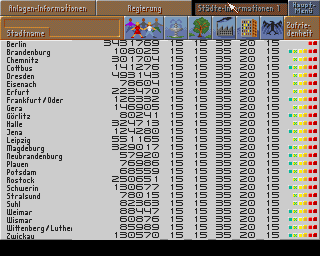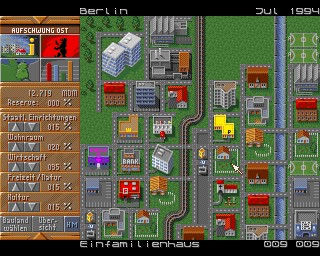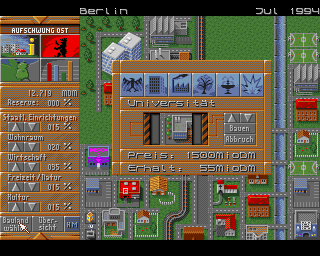Retro Replay Review
Gameplay
Aufschwung Ost challenges players with a two-tiered management system that balances big-picture planning and detailed city development. On the macro scale, you oversee the rehabilitation of East Germany’s infrastructure—building power plants, extending highways, and allocating budgets for regional growth. This grand strategy layer demands long-term thinking: decisions you make early on regarding energy production or transport networks will reverberate throughout the playthrough, influencing your city-level options down the line.
(HEY YOU!! We hope you enjoy! We try not to run ads. So basically, this is a very expensive hobby running this site. Please consider joining us for updates, forums, and more. Network w/ us to make some cash or friends while retro gaming, and you can win some free retro games for posting. Okay, carry on 👍)
Switching to the micro scale, the game transforms into a SimCity-like builder where you manage individual towns and districts. Here you zone residential, commercial, and industrial areas, set local tax rates, and respond to citizens’ needs such as healthcare, education, and public transit. The transition between the two scales feels fluid, and each decision at the macro level unlocks new possibilities—and challenges—at the city level. Striking the right balance between large-scale infrastructure projects and neighborhood needs is the core enjoyment of the simulation.
Being scenario-driven, Aufschwung Ost offers seven different setups, beginning with the historical “East Germany – 1989” environment and extending to hypothetical situations rife with national debt, industrial pollution, or energy crises. Each scenario provides a fresh set of obstacles, but the lack of a defined “endgame” means the experience continues indefinitely until you resign or are voted out of office. This open-ended structure encourages creative problem-solving but may feel aimless to players seeking clear victory conditions.
Graphics
Visually, Aufschwung Ost adopts a clean, functional aesthetic that prioritizes data clarity over flashy presentation. The map of East Germany is rendered in muted earth tones, allowing infrastructure elements—roads, power lines, and industrial zones—to stand out crisply. While not groundbreaking by today’s standards, the interface is intuitive: icons are large enough to be meaningful, and overlays for pollution, traffic, and resource distribution are quickly toggled.
At the city scale, the level of detail increases convincingly. Buildings range from dilapidated East German high-rises to modernized commercial blocks, reflecting your urban renewal efforts. Animated citizens milling about streets and vehicles traversing your road networks add life to the environment, though these animations can feel repetitive during extended play sessions. Still, the game’s color palette shifts subtly as your regions develop: greys give way to lush greens and brighter commercial districts, offering visual feedback on progress.
Performance is generally stable even on modest hardware, thanks to efficient rendering of both strategic overlays and local city views. Transition times between the two scales are minimal, preserving immersion. If the graphics sometimes lack polish compared to contemporary city-builders, the clarity of information and coherent visual style ensure you’re never confused about what’s happening on your economic and political frontier.
Story
Aufschwung Ost situates you in a pivotal moment of history: November 9th, 1989, the night the Berlin Wall fell. This historical backdrop is more than window dressing; it fundamentally shapes the game’s atmosphere. Newspapers and event prompts reference reunification debates, funding tensions with West Germany, and citizens’ hopes and anxieties, providing context for your policy decisions and allowing you to feel the weight of your newfound political office.
Beyond the initial scenario, the storytelling becomes emergent rather than scripted. Each scenario’s unique challenges—whether tackling rampant pollution in an industrialized region or confronting skyrocketing national debt—crafts its own narrative arc. By balancing budgets, orchestrating public campaigns, and responding to simulated citizen feedback, players effectively write their own version of East Germany’s resurgence, achieving personal storytelling milestones such as electrifying entire districts or reversing unemployment trends.
While the lack of a linear campaign or character-driven plot might disappoint those seeking a traditional narrative, the game’s commitment to a realistic political simulator means that every decision feels consequential. Your administration’s legacy—measured by citizen satisfaction ratings, infrastructure quality, or economic prosperity—emerges through gameplay rather than cutscenes, creating a unique story for each playthrough.
Overall Experience
Aufschwung Ost offers a deep and thoughtful simulation for players who relish complex management games. Its dual-scale gameplay keeps your attention engaged as you juggle national ambitions with local realities. The open-ended nature of each scenario ensures that no two sessions unfold identically, and the game’s historical context adds a level of gravitas not always found in business sims.
However, the absence of definitive victory conditions can be a double-edged sword. If you thrive on setting personal objectives—whether reducing pollution by a certain percentage or expanding the highway network by dozens of kilometers—the sandbox environment will feel liberating. Conversely, players accustomed to level-based progression or clear win/lose states may find themselves adrift without a goalpost to pursue.
Ultimately, Aufschwung Ost is a niche gem for strategy enthusiasts fascinated by post-Cold War Europe and public administration challenges. Its approachable interface, coupled with the depth of strategic and city-building layers, yields hours of engrossing gameplay. For potential buyers eager for a political-business simulator that blends historical flavor with open-ended strategy, Aufschwung Ost delivers a richly textured and enduring experience.
 Retro Replay Retro Replay gaming reviews, news, emulation, geek stuff and more!
Retro Replay Retro Replay gaming reviews, news, emulation, geek stuff and more!









Reviews
There are no reviews yet.